PROPERTIES OF PARALLEL LINES
Subscribe to our ▶️ YouTube channel 🔴 for the latest videos, updates, and tips.
Property 1 :
Let m1 and m2 be the slopes of two lines.
If the two lines are parallel, then their slopes will be equal.
m1 = m2
Property 2 :
Let us consider the general form of equation of a straight line.
ax + by + c = 0
If the two lines are parallel, then their general forms of equations will differ only in the constant term and they will have the same coefficients of x and y.
ax + by + c1 = 0
ax + by + c2 = 0
Property 3 :
Let us consider the slope intercept form of equation of a straight line.
y = mx + b
If the two lines are parallel, then their slope-intercept form equations will will differ only in the "y"- intercept.
y = mx + b1
y = mx + b2
Property 4 :
Let l1 and l2 be two lines.
If the two lines are parallel, the angle between them and the positive side of x-axis will be equal.
The figure given below illustrates the above situation.
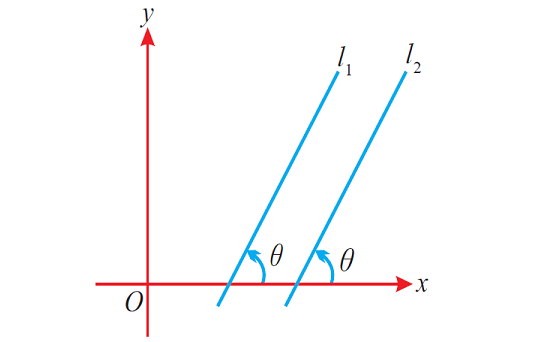
Property 5 :
If the two lines are parallel, the perpendicular distance between them will be same at everywhere.
The figure given below illustrates the above situation.
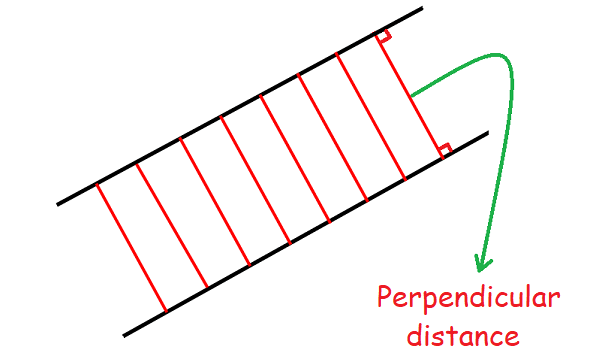
Property 6 :
Let l1 and l2 be two parallel lines and the line m intersects the lines l1 and l2.
The figure shown below illustrates the above situation.
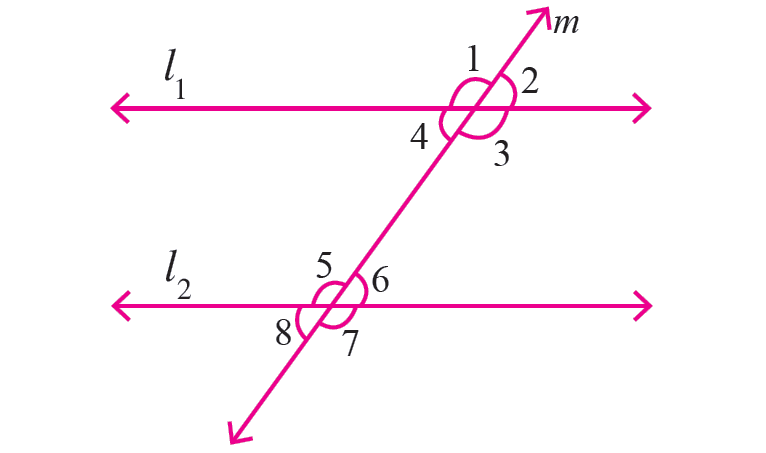
From the above figure, we can have the following important results.
|
Vertically opposite angles are equal. |
∠1 = ∠3 ∠2 = ∠4 ∠5 = ∠7 ∠6 = ∠8 |
|
Corresponding angles are equal. |
∠1 = ∠5 ∠2 = ∠6 ∠3 = ∠7 ∠4 = ∠8 |
|
Alternate interior angles are equal. |
∠3 = ∠5 ∠4 = ∠6 |
|
Consecutive interior angles are supplementary. |
∠3 + ∠6 = 180° ∠4 + ∠5 = 180° |
|
Same side exterior angles are supplementary. |
∠1 + ∠8 = 180° ∠2 + ∠7 = 180° |
Solving Problems Using Properties of Parallel Lines
Problem 1 :
The slopes of the two lines are 7 and (3k + 2). If the two lines are parallel, find the value of k.
Solution :
If two lines are parallel, then their slopes are equal.
3k + 2 = 7
Subtract 2 from both sides.
3k = 5
Divide both sides by 5.
k = 5/3
Problem 2 :
If the following equations of two lines are parallel, then find the value of k.
3x + 2y - 8 = 0
(5k + 3)x + 2y + 1 = 0
Solution :
If the two lines are parallel, then their general forms of equations will differ only in the constant term and they will have the same coefficients of x and y.
To find the value of k, equate the coefficients of x.
5k + 3 = 3
Subtract 3 from both sides.
5k = 0
Divide both sides by 5.
k = 0
Problem 3 :
Find the equation of a straight line is passing through (2, 3) and parallel to the line 2x - y + 7 = 0.
Solution :
Because the required line is parallel to 2x - y + 7 = 0, the equation of the required line and the equation of the given line 2x - y + 7 = 0 will differ only in the constant term.
Then, the equation of the required line is
2x - y + k = 0 ----(1)
The required line is passing through (2, 3).
Substitute x = 2 and y = 3 in (1).
2(2) - 3 + k = 0
4 - 3 + k = 0
1 + k = 0
k = -1
So, the equation of the required line is
(1)----> 2x - y - 1 = 0
Problem 4 :
Verify, whether the following equations of two lines are parallel.
3x + 2y - 7 = 0
y = -1.5x + 4
Solution :
In the equations of the given two lines, the equation of the second line is not in general form.
Let us write the equation of the second line in general form.
y = -1.5x + 4
1.5x + y - 4 = 0
Multiply by 2 on both sides,
3x + 2y - 8 = 0
Now, let us compare the equations of two lines,
3x + 2y - 7 = 0
3x + 2y - 8 = 0
The above two equations differ only in the constant term.
So, the equations of the given two lines are parallel.
Problem 5 :
Verify, whether the following equations of two lines are parallel.
5x + 7y - 1 = 0
10x + 14y + 5 = 0
Solution :
In the equation of the second line 10x + 14y + 5 = 0, the coefficients of x and y have the common divisor 2.
So, divide the second equation by 2.
5x + 7y + 2.5 = 0
Now, let us compare the equations of two lines,
5x + 7y - 1 = 0
5x + 7y + 2.5 = 0
The above two equations differ only in the constant term.
So, the equations of the given two lines are parallel.
Problem 6 :
In the figure given below, let the lines l1 and l2 be parallel and m is transversal. If ∠F = 65°, find the measure of each of the remaining angles.
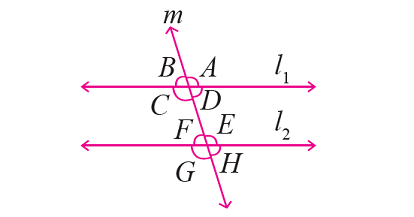
Solution :
From the given figure,
∠F and ∠H are vertically opposite angles and they are equal.
∠H = ∠F ----> ∠H = 65°
∠H and ∠D are corresponding angles and they are equal.
∠D = ∠H ----> ∠D = 65°
∠D and ∠B are vertically opposite angles and they are equal.
∠B = ∠D ----> ∠B = 65°
∠F and ∠E are together form a straight angle.
∠F + ∠E = 180°
Substitute ∠F = 65°.
∠F + ∠E = 180°
65° + ∠E = 180°
∠E = 115°
∠E and ∠G are vertically opposite angles and they are equal.
∠G = ∠E ----> ∠G = 115°
∠G and ∠C are corresponding angles and they are equal.
∠C = ∠G ----> ∠C = 115°
∠C and ∠A are vertically opposite angles and they are equal.
∠A = ∠C ----> ∠A = 115°
Therefore,
∠A = ∠C = ∠E = ∠G = 115°
∠B = ∠D = ∠F = ∠H = 65°
Problem 7 :
In the figure given below, let the lines l1 and l2 be parallel and t is transversal. Find the value of x.
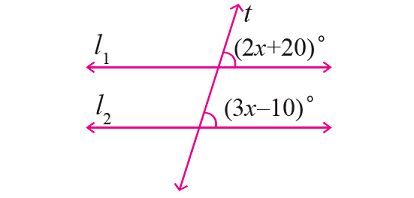
Solution :
From the given figure, (2x + 20)° and (3x - 10)° are corresponding angles.
So, they are equal.
(2x + 20)° = (3x - 10)°
2x + 20 = 3x - 10
Subtract 2x from both sides.
20 = x - 10
Add 10 to both sides.
30 = x
Problem 8 :
In the figure given below, let the lines l1 and l2 be parallel and t is transversal. Find the value of x.
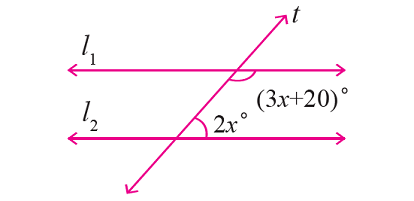
Solution :
From the given figure, (3x + 20)° and 2x° are consecutive interior angles.
So, they are supplementary.
(3x + 20)° + 2x° = 180°
3x + 20 + 2x = 180
Simplify.
5x + 20 = 180
Subtract 20 from both sides.
5x = 160
Divide both sides by 8.
x = 32
Subscribe to our ▶️ YouTube channel 🔴 for the latest videos, updates, and tips.
Kindly mail your feedback to v4formath@gmail.com
We always appreciate your feedback.
About Us | Contact Us | Privacy Policy
©All rights reserved. onlinemath4all.com
Recent Articles
-
AP Calculus BC Problems with Solutions
Dec 20, 25 10:51 AM
AP Calculus BC Problems with Solutions -
AP Precalculus Problems and Solutions (Part - 1)
Dec 20, 25 10:49 AM
AP Precalculus Problems and Solutions (Part - 1) -
AP Calculus AB Problems with Solutions (Part - 1)
Dec 20, 25 10:49 AM
AP Calculus AB Problems with Solutions (Part - 1)
